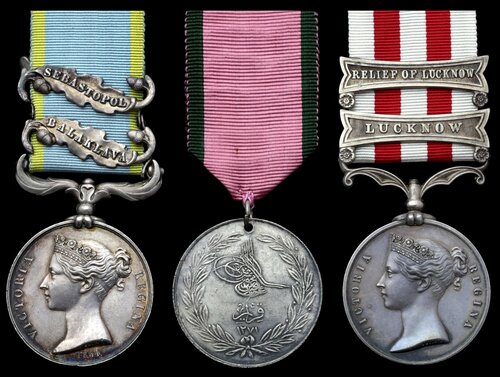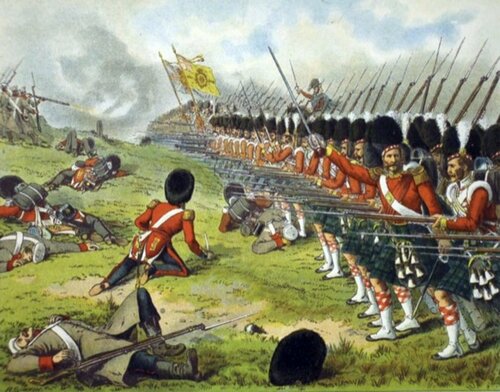Auction: 22001 - Orders, Decorations and Medals
Lot: 169
The exceptional 'Thin Red Line' and 'Relief of Lucknow' group of three to Private J. Kinnear, 93rd Foot (Sutherland Highlanders), who was killed in action during the capture of Lucknow in March 1858
Crimea 1854-56, 2 clasps, Balaklava, Sebastopol (1205 James Kinnar 93d Sutherland Highlanders), engraved in the normal style for the unit, note surname spelling; Indian Mutiny 1857-59, 2 clasps, Lucknow, Relief of Lucknow (Jas. Kinnear, 93rd Highlanders); Turkish Crimea 1855, unnamed as issued, good very fine (3)
James Kinnear served with the 93rd Foot (Sutherland Highlanders) during the Crimean War. Part of the Highland Brigade under Sir Colin Campbell, this regiment was positioned on the extreme left of the Allied army at the Battle of the Alma on 20 September 1854. When Lord Raglan finally ordered the advance at 1 p.m. that day, the army had been within range of Russian batteries for several hours, and had already suffered severe losses. The Highland Brigade crossed the River Alma and advanced up the enemy bank in echelon, led by the 42nd Foot (Black Watch). Described as 'mad with warlike joy', the 93rd engaged the Sousdal and Kazan Regiments in a bitter musketry duel, forcing them to withdraw.
Kinnear's service records confirm that, in addition to fighting at the Alma, he was also present at the Battle of Balaklava on 25 October 1854. In that desperate action, the Allies held at bay a much larger Russian host, intent on capturing the British supply port at Balaklava Harbour. The 93rd Foot was positioned just north of Balaklava, near the village of Kadikoi and overlooking the 'South Valley'. Down this valley poured 3,000 Cossacks and hussars led by General Rhyzov. While the bulk of this force was repelled by Scarlett's Heavy Brigade in a brilliant charge, a 400-strong detachment peeled off towards the 93rd's position. Drawn up in a two-deep line, the Sutherland Highlanders appeared to The Times correspondent W. H. Russell as 'a thin red streak tipped with steel'. From this derived the legend of the 'Thin Red Line'.
Sir Colin Campbell, riding behind the line on his charger, told his men:
'...there is no retreat from here! You must die where you stand!'
To which John Scott, the right-hand marker of Lieutenant Burrough's Company, replied:
'Ay, ay, Sir Colin; and needs be we'll do that!'
As the Russian cavalry approached, some Highlanders showed a mind to rush forward and engage them. Campbell called out to them fiercely:
'Ninety-third! Ninety-third! Damn all that eagerness.'
At last, when the enemy were within range of their Minié rifles, the Highlanders received the order to fire. A crashing volley rang out, which took the impetus from the charge, but one Russian squadron wheeled to the left and tried to encircle the 93rd. In response, Captain Ross's Grenadier Company refused the right flank, and delivered volley after volley into the disordered mass. Rhyzov's cavalry scampered back up the valley. One can only imagine the damage they would have caused if let loose in Balaklava Harbour.
Kinnear's service records also confirm that he was present at the fall of Sebastopol on 8 September 1855. He therefore served throughout the Crimean campaign, from the initial landing at Kalamita Bay a year earlier to the eventual Allied victory. The Siege of Sebastopol was marked by a sordid mode of trench warfare that presaged the First World War. Most British regiments took their turn in the forward trenches, and the attrition rate was appalling. The Redan, a formidable earthwork designed by Eduard Totleben (a German in Russian service), was never actually captured by the British, despite several brave attempts.
When news of the Indian Mutiny spread in June 1857, Sir Colin Campbell hastened to Bengal, closely followed by the 93rd Foot. From Calcutta, the regiment was transported up the River Ganges as far as Cawnpore. On 11 November Campbell rode into the British camp, greeted by wild cheers from his old regiment. Recent drafts had brought the 93rd Foot up to 1,000 men, of whom 700 proudly wore the Crimea Medal with 'Alma' and 'Balaklava' clasps. To Doctor Monro of the Naval Brigade, the 93rd were 'all in the very prime of manhood, in magnificent condition and dressed in full Highland costume.'
Having marched to the (second) relief of Lucknow, the 93rd led the charge against the Sikanderabagh, a key rebel stronghold. The 4th Punjab Infantry also took part in the storming, which involved running straight into a 'killing zone' of enemy fire. The 93rd had seen the grisly remains of women and children at the Bibigarh, Cawnpore. With a cry of 'Remember Cawnpore', the Highlanders surged forward as their pipers struck up the Regimental Charge, 'Haughs of Cromdale'. Initially the breach into which these men poured was just three feet high by three and a half feet wide. Wearing their tall feathered bonnets, they had to scramble through this hole in single file, all the while being stabbed and bayonetted by frenzied mutineers inside. Gradually, as more men entered, the main gate was forced open and a tidal wave of Highlanders swept forward, killing some 2,000 rebel sepoys. For this action alone, the regiment won six Victoria Crosses.
Kinnear was present at both the relief and eventual capture of Lucknow, the latter taking place in March 1858. Barely had Sir Colin Campbell's troops entered the suburbs of the city when Kinnear was killed in action, on 11 March 1858.
Subject to 20% VAT on Buyer’s Premium. For more information please view Terms and Conditions for Buyers.
Sold for
£4,500
Starting price
£2400







